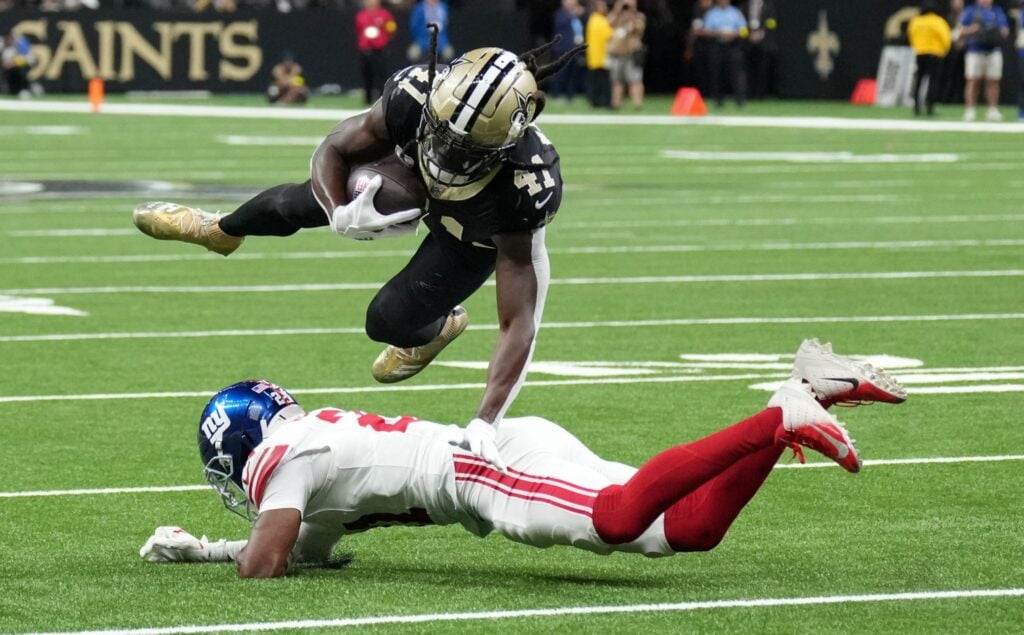Red-zone opportunity share is one of the most predictive usage signals in fantasy football. Looking only at Weeks 5 and 6, a handful of players hold outsized roles near the goal line that are not reflected in consensus rest-of-season ranks. The focus here is on non-obvious edges managers can act on in standard 12-team formats.
Fantasy Football Red Zone Share

“Share of opportunities” combines paths to touches for multi-use backs. The window is small, but red-zone roles tend to be sticky.
Alvin Kamara, New Orleans Saints — Two-Way TD Equity the Market Is Missing
Kamara controls 63% of New Orleans’ red-zone carries and 43% of red-zone targets in this two-week window, for 53% total red-zone opportunity share. That is rare, dual-path touchdown access. Yet his consensus ROS rank sits in the mid-sixties. Even if overall yardage ebbs and flows, this level of decision-making trust near the stripe is the profile of a weekly RB2 with RB1 spikes. In leagues where he is priced as a midpack starter, that gap is actionable.
Zach Charbonnet, Seattle Seahawks — The Short-Yardage Tilt
Charbonnet owns 53% of Seattle’s red-zone opportunities over Weeks 5 and 6, almost entirely on the ground. In the same span, Kenneth Walker III sits at only 17% total. The takeaway is simple: Seattle has tilted the money-zone rushing work to Charbonnet lately. That shift explains Walker’s touchdown volatility despite his big-play profile. Treat Charbonnet as a matchup-driven FLEX start when the Seahawks project for multiple red-zone trips, and temper weekly RB1 expectations for Walker until the split changes.
Zonovan Knight, Arizona Cardinals — Start While It Lasts
Knight accounts for 42% of the Cardinals’ red-zone carries in this sample and 21% of total red-zone opportunities. His ROS rank lives in fringe territory, but the recent usage shows a staff willing to ride the hot hand in close. That creates a clear, short-term runway. In twelve-team leagues, Knight profiles as a spot starter while this distribution holds; deeper formats should already have him active when Arizona’s implied total is playable.
Ladd McConkey, Los Angeles Chargers — Designed Looks in Tight
McConkey owns 31% of the Chargers’ red-zone targets across Weeks 5 and 6. After some bad weeks to start the season, that is a meaningful signal. It confirms what the route tree suggests on film: motion and option routes designed to show up in compressed space. Touchdowns often lag target quality; McConkey’s usage suggests he is now closer to his last year self.
Courtland Sutton, Denver Broncos — Adjust the Weekly Expectation
Sutton’s brand is touchdowns, but the past two weeks tell a different story. He sits at 20% of Denver’s red-zone targets and only 10% of total opportunities. Meanwhile, ancillary pieces have siphoned chances inside the twenty. The result is a spike-week, boom-bust profile rather than a bankable WR2. In shallow leagues, he becomes a soft sell if name value still carries weight. In deeper formats, set expectations around matchups and team totals rather than chasing early-season highlights.
Practical Moves for Week 7 and Beyond
-
Trade/Acquire: Alvin Kamara where priced as a mid-tier RB2; Ladd McConkey if he can still be bought at a discount.
-
Stream/Deploy with intent: Zach Charbonnet in projected positive scripts; Zonovan Knight while Benson is not back and red-zone usage does not change.
-
Reframe: Courtland Sutton as a matchup-dependent FLEX rather than an automatic start.
Main Image: Rich Storry-Imagn Images
The post Fantasy Football Red Zone Share: Week 6 Market Inefficiencies appeared first on Last Word on Pro Football.
